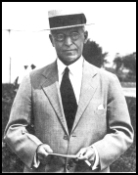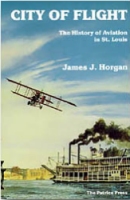

1875-1946 |
 |
 |
From CITY OF FLIGHT |
|
Symptomatic of the wartime just ended were the number of military titles among the officers and governors of the Aero Club of America.
The president was Col. Jefferson DeMont Thompson; Rear Adm. Bradley A Fiske and Lt Godfrey L. Cabot were vice-presidents; Col
Charles Eliot Warren was treasurer; and the governors included Col. James E. Blair, Jr., Brig. Gen. Robert K. Evans, Lt. Col. F.L.V.
Hoppin. and Maj. Albert Bond Lambert, Maj. Charles J. Glidden was acting chairman of the Contest Committee.
I was privileged to know Henry during several years before his death. He was an fascinating raconteur and a lifelong friend of aviation. I heartily recommend his book to you for the complete story of the Gordon Bennett Races |
|
President Theodore Roosevelt, the first president to ride in an airplane, took his first ride at the Kinloch airfield. Soon after, the first experimental parachute jump in the world took place in St. Louis. Then, Major Albert Lambert purchased the 550 acres of land known as Kinloch Field and renamed it Lambert Field. Major Lambert was the first person in St. Louis to receive his private pilot's license, having taken his first flight in an airplane with Orville Wright. In June 1920, Major Lambert was not only a man with a dream, but also one with great foresight and generosity. His vision enabled St. Louis to become a key in the growing aviation industry. What many would have viewed as an ordinary hayfield, on June 18, 1920, became a 170 acre airfield. At his own expense, he developed the airfield by clearing, grading, and draining the land and erecting hangars. Eight years later, Lambert's airfield was a base for passenger and freight service. History of Lambert Field St. Louis International Airport Website. Click on title to read the rest of the story. |
|
(Ed. Note) (F.A.I. 61, Sept. 20, 1911) I know of no group of men, scattered all over the country, who have so instinctively held together in sentiment, mutual regard and loyalty. Comparatively few in numbers and only one or two in each location, the Early Birds constitute a rather romantic and distinguished organization and one of treasured membership. In 1906 I met Lt. Frank P. Lahm in Paris, France. Centered around him were Cortlandt F. Bishop, Alan R. Hawley, James C. McCoy (three presidents of the Aero Club of America), also Augustus Post, Lt. C. de. Forest Chandler, Clifford B. Harmon and Major Hersey. All of these men became famous as international balloon pilots. It was right there and then that I caught the 'fever' and qualified as a balloon pilot with License No. 18, dated 1907. Lt. Lahm, now Brigadier General retired, won the first International Balloon Race from Paris, 1906, which resulted in the second race of 1907, in my home town of St. louis. The above-named men were either participants or served as officials for this event. I had my first aeroplane flight with Orville Wright, 1090, which I soon followed up with Brookins as instructor to qualify for License No. 61, almost a Grandpa License. The old Wright Model B -- what a ship! I wonder how many of you will remember when this model took off on skids, and how Capt. Hugh Willoughby would grease the grass for a quick start. In those days if a plane were off balance we would tie a brick or two on the offending side and often slip a board on the wing as a passenger seat. We had to learn how to settle down with grace in cow pastures and jump barbed wire fences. In 1910 we had a big aviation meet in St. Louis. The entire Wright organization with six Model Bs were on hand, headed by Roy Knabenshue, manager. You all know him. His job was to collect a guarantee chack for $25,000 from me, and keep the boys on the ground; Hoxey, Brookins, Welsh, Turpin, Parmelee, Johnstone, Ogilvie and La Blanc, the famous French flyere who attained 60 miles per hour. Colonel Theodore Roosevelt made a flight with Hoxey and we bombed a wooden battleship built for the purpose. Bud Morris and Jack Vilas were just about breaking out fo the shell when we all went to Chicago in 1911 to sprinkle the grass and fly low over Michigan Avenue; Beachey was arrested for that stunt. He had had too much 'bird seed' for lunch. The Queen of the Early Birds is Marjorie Stinson. I have in front of me a letter dated April 29, 1915, in reference to her desire and eagerness to join the U. S. Aviation Reserve Corps, and in which she is rather concerned that her Expert Aviation Certificate, for which she had applied and qualified, was delayed because she was not yet twenty-one years of age. courtesy of Steve Remington - CollectAir |
|
Major Lambert was born in St. Louis, December 6, 1874, the son of Jordan W. Lambert of Alexandria, Va., and Lily (Winn) Lambert. He attended Smith Academy and graduated from Page's School in Virginia in .........where he was on the varsity football team. In 1898 he married Myrtle McGrew. Subsequently he became president of Lambert Pharmacal Co. and the Paint, Oil & Drug Co., vice president of others, and a director of the Mechanics American Bank, president of the Board of Police Commissioners, and active in civic organizations. He met Lieutenant Frank P. Lahm and his father, and Henry B. Hersey in Paris the year of Lahm's winning of the first Gordon Bennett Balloon Race, and then Cortland Bishop, Alan Hawley and J. C. McCoy, and became enthused over aerostation. The first month of 1907 he was one of the prime movers in the organization of the Aero Club of St. Louis. Lt. Lahm had brought the international balloon race to America and some place had to be found for its take-off. Augustus Post had traveled the Orient with Dan Nugent and felt well enought acquainted to write him on the possible selection of St. Louis. He invited Post and Alan R. Hawley to St. Louis and there they met a group of prominent men gathered by Lambert at luncheon---Governor Francis, "Bert" Walker, L. D. Dozier, A. T. Smith, "Tony" Faust and others---who underwrote the funds required for such a great and novel event. In April of 1908 Lambert made a series of ascents in France with Frank S. Lahm and others and continued at St. Louis in the fall with Honeywell, qualifying for his balloon certificate. In 1909 he was taken for a flight by Orville Wright and then Brookins became his instructor until he qualified for his airplane license, September 15, 1911. He represented one of the insurgent clubs in the movement to obtain an organization more nationally representative than the Aero Club of America and at one of the club's meetings obtained the passage of a resolution urging upon the Army more active participation in military aeronautics. The same year of 1910 he was instrumental in the organization of St. Louis' big ten-day aviation meet where ex-President Theodore Roosevelt flew with Hoxsey and Drew dropped dummy bombs on a "battleship" marked out on the field. In 1913 he organized the "U. S. Aviation Reserve Corps" with the approval of Secretary of Navy Daniels, C/S Leonard Wood, CSO Scriven, Capt. Mark L. Bristol, USN, and the Aero Club of America. Some 55 of the greatest aviators on the American list were signed up but the organization did not become an operating entity and passed out of existence under the recruiting system of World War I. Early in 1917 he offered his services to the Aviation Section of the Signal Corps and was commissioned First Leiutenant, ordered to active duty and put on flying status. By September he was in command of the balloon school of...........took the group in San Antonio for the winter. he was again promoted and rated Junior Military Aviator. By this time his three brothers were also in the service. He continued to command the school until the inauguration of the Signal Corps' own school at Camp John Wise, to which he was ordered and the MAS School passed into history. During his school work he lectured, made ascents, was on various boards and developed a parachute for target purposes to replace balloons. His military career ended with his discharge, at his own request, in February of 1919. He gave "Lambert's Cow Pasture" for the first flying field in St. Louis, now the center of a $3,000,000 improvement, and later became chairman of the St. Louis Airport Committee. In the last issue of Chirp he wrote: "I know of no group of men who have so instinctively held together in sentiment, mutual regard and loyalty as the Early Birds---a romantic and distinguished organization and one of treasured membership." Of this "Prophet of Aviation" the St. Louis Post Dispatch says; "He dreamed, livved and preached the future of flying and the place of St. louis as a natural center for a national net of airlanes. Thus, he was a Machine Age Pioneer who lived to see his frontier, as it were, built up and thickly settled as he had prophesied it would be. Builders of Lambert-St. Louis Field remember that major Lambert worked himself on the grading of the runways. "How steadfastly he had St. Louis' aviation interest at heart was made clearer than ever by his blunt letter to the Municipal Airport Commission only two weeks ago. He might have taken pardonable pride in the flying field named for him. He did nothing of the sort. He said it was outmoded and would not be able to meet present requirements until 1951---in other words it is already five years behind and falling farther behind every day. The community's best way to remember Major Lambert, his vision, his work, and his service, will be to overhaul its aviation program on a big basis and plan for the future as St. louis' No. 1 aviation enthusiast and expert proposed." courtesy of Steve Remington - CollectAir |
|
on the Find A. Grave website by clicking on: Albert Lambert. |

City of Flight : The History of Aviation... The History of Aviation in St. Louis by James J. Horgan The Patrice Press. |
|
The Gordon Bennett Races by Henry Serrano Villard Smithsonian Institution Press |


|